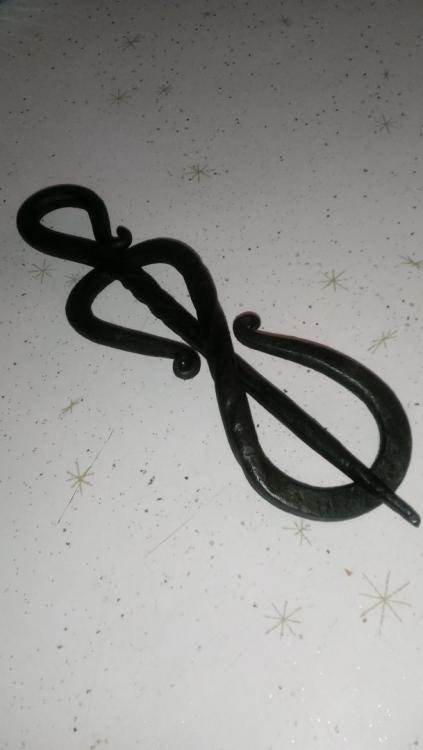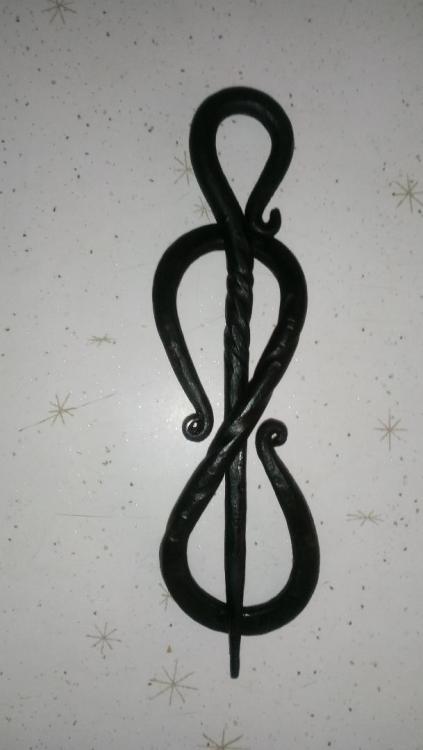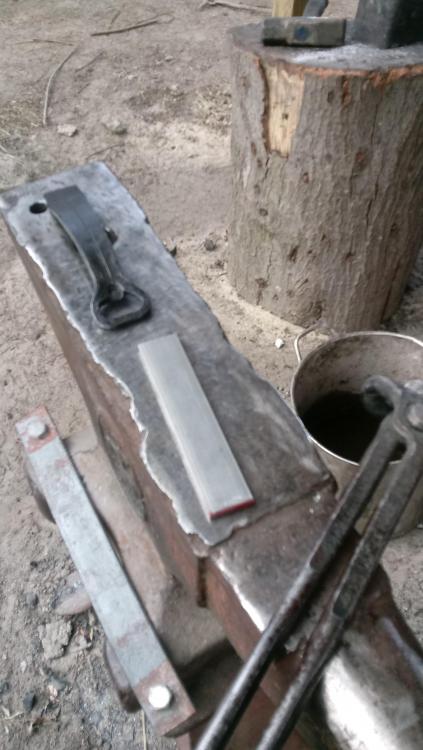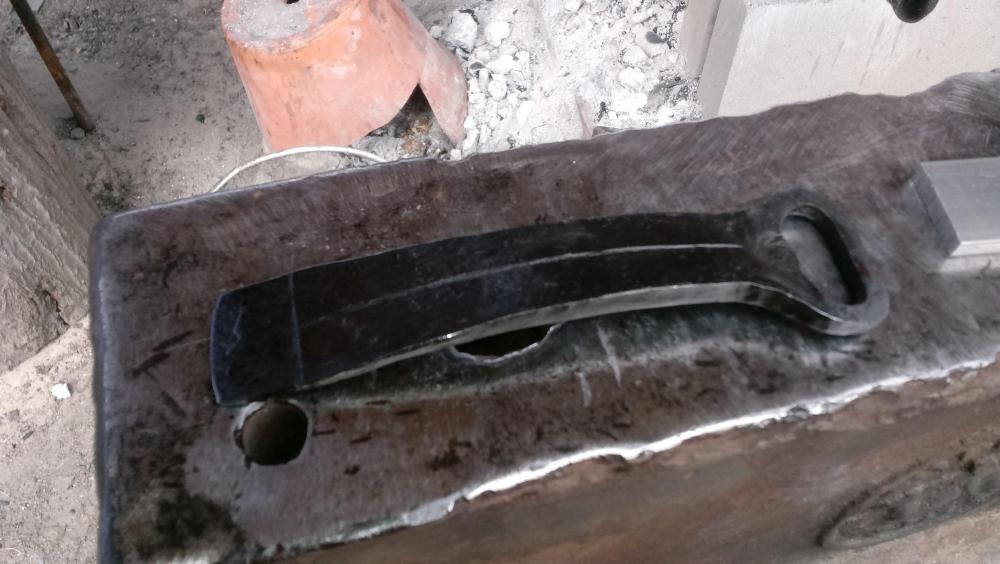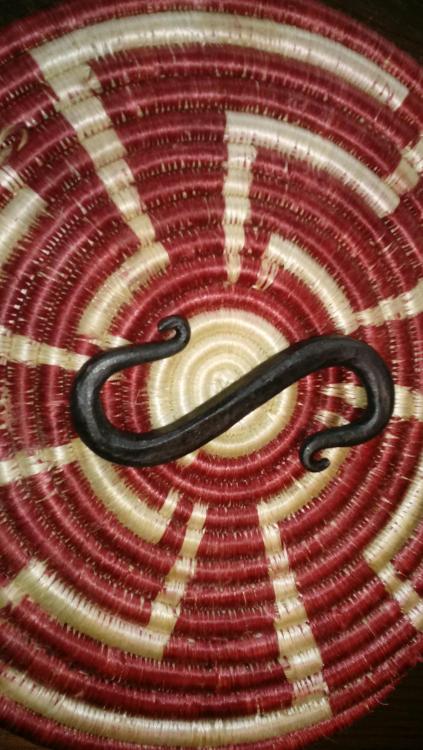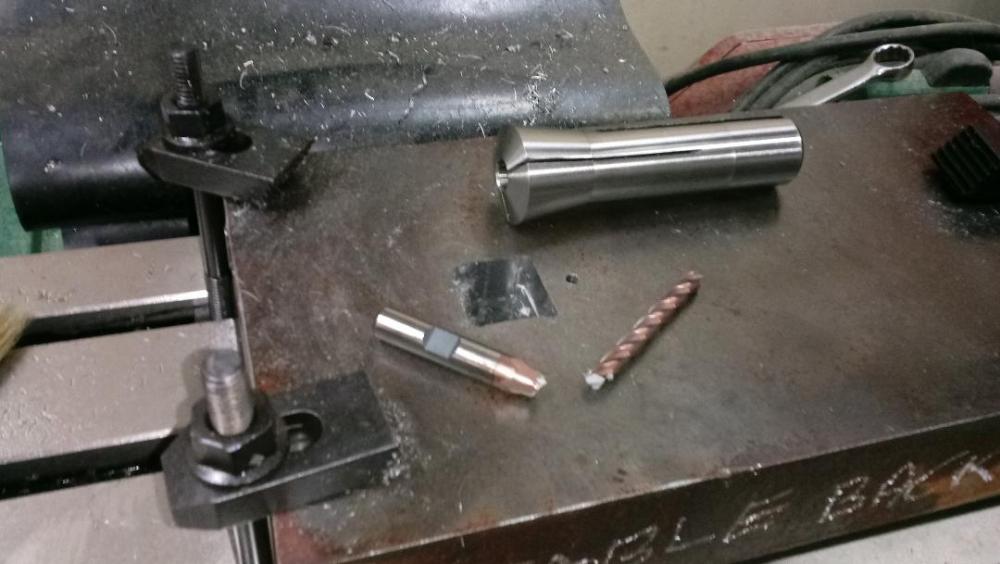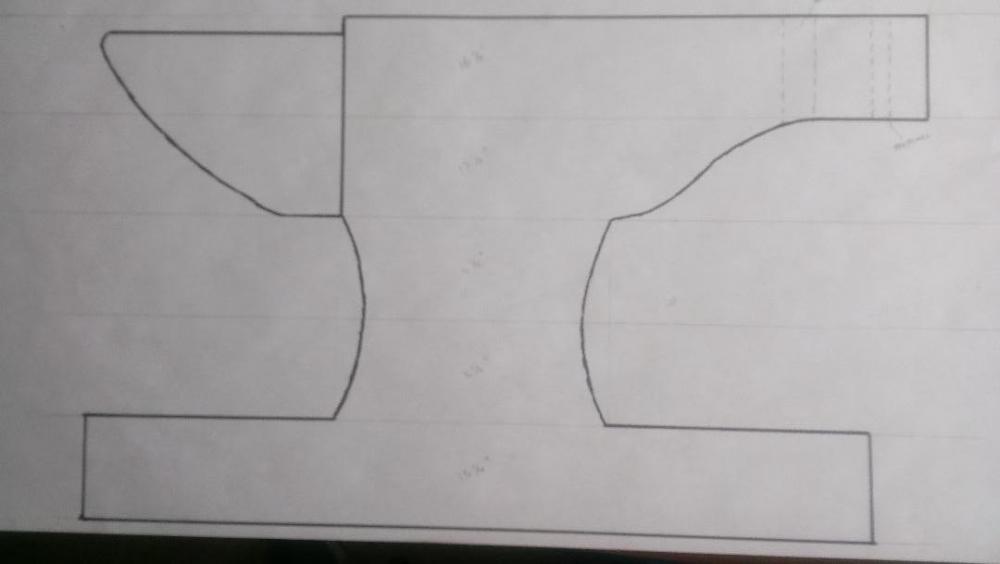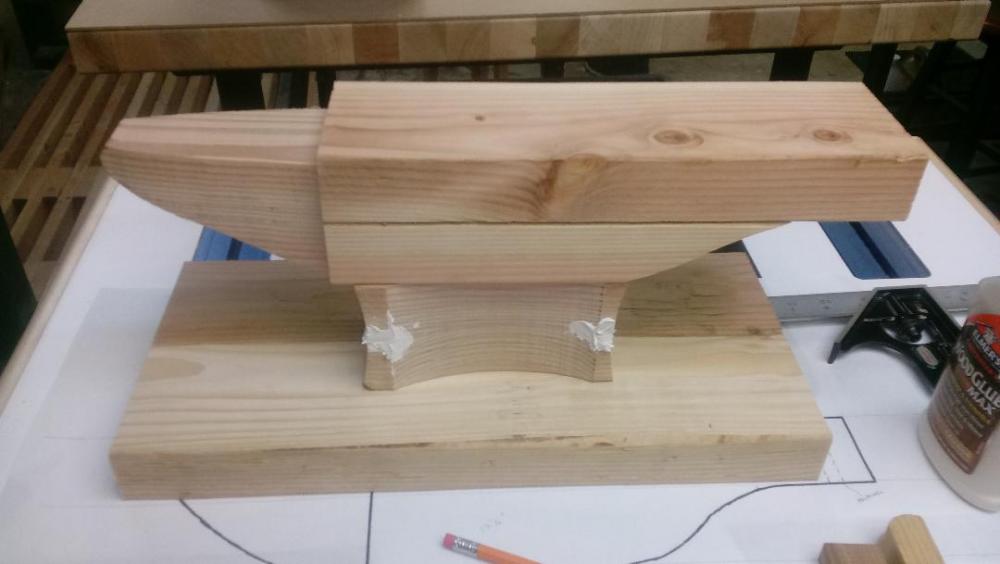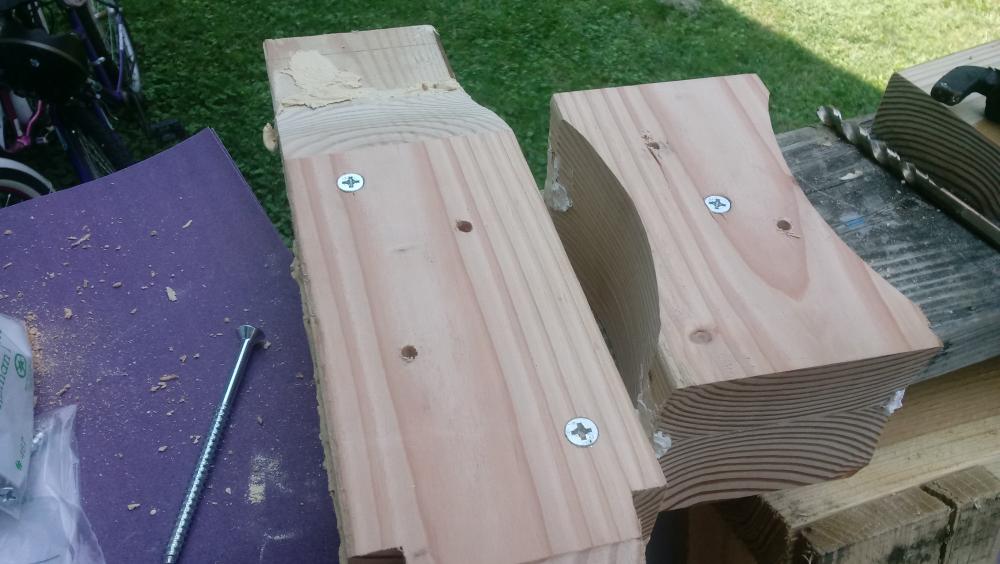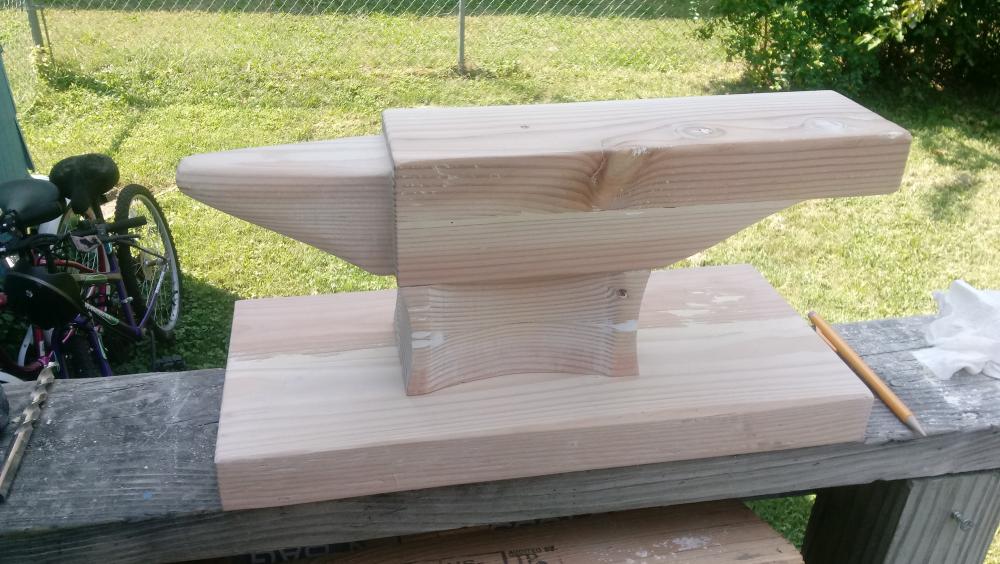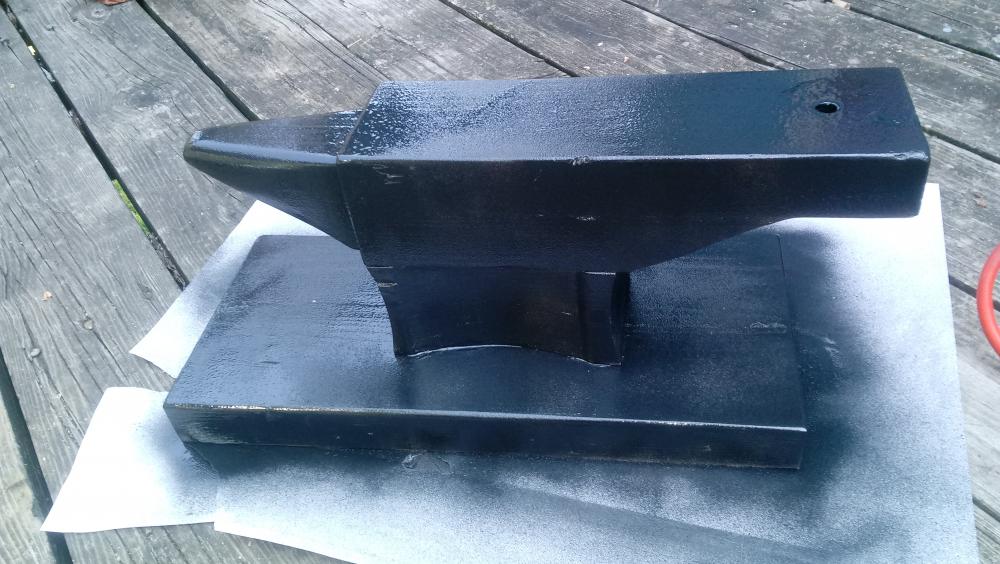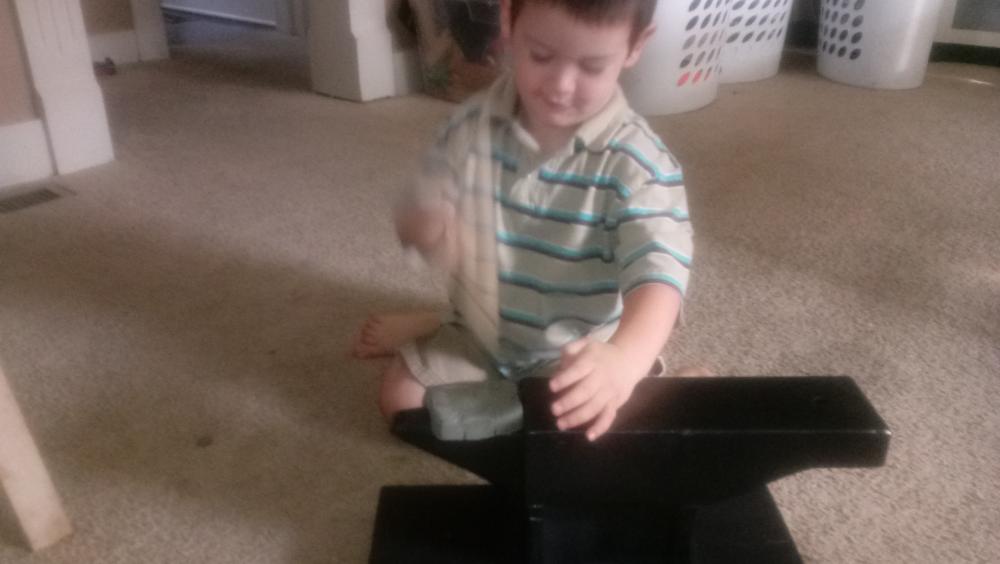-
Posts
152 -
Joined
-
Last visited
Content Type
Profiles
Forums
Articles
Gallery
Downloads
Events
Everything posted by SFC Snuffy
-
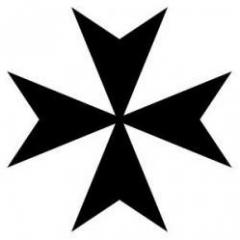
What did you do in the shop today?
SFC Snuffy replied to Mark Ling's topic in Blacksmithing, General Discussion
58er, those are really, really gorgeous! Do you make your own blanks? -

What did you do in the shop today?
SFC Snuffy replied to Mark Ling's topic in Blacksmithing, General Discussion
Bad estimation on my part. I knew what I wanted to make (a hairpin - hairpiece?) and had a good idea of how to do it. I used the stock I had available at the time, and this is what I got: I think it's nicely proportioned, and considering all the bends were done with a hand-held bending fork and a hammer I'm happy with it. But... it's about 50% too large. So it's a success as a proof of concept, but not as the gift I intended. Next week I'll flatten the one piece out and keep it as an S-hook, and maybe thread the other for use as a plant hanger or some such. I'll try again with 1/4" or 3/16" stock. -
One of the machine shops where I work, specifically the one in the building I work in, has half of a monstrous old LeBlond lathe. The bed is easily 12 feet and, I'm led to believe, is only half of the machine - the rest is in another building. The chuck that's in it is easily four feet in diameter and I'd guess the swing is probably two-and-a-half feet, or so. I'm fairly sure you could turn railroad wheelsets on it. The machine shop in a different building has some of the largest machines I've ever seen. Though they were not intended for such, I could easily imagine them building the parts and pieces for Sherman tanks or artillery pieces. Unfortunately, most of it is never used. The plant employs only a few full-time machinists, and only a couple know how to operate equipment that old. Back on topic: I'd love to have a good lathe to play with. I think you'll spend some time dreaming up things to do with your new capabilities and capacity, and before long you'll wonder how you ever made it without (or with a smaller version).
-
I've done linseed oil on a couple of pieces. I find that a few coats, particularly if I coat it then put it back over the fire to "cook," repeating two or three times really gives it a nice, tough, black finish.
-

What did you do in the shop today?
SFC Snuffy replied to Mark Ling's topic in Blacksmithing, General Discussion
With a baby?! Bud, your days of "relaxing" are over! My son's going to be four in about a month, and while he's definitely my pride and joy and I take a lot of pleasure from the time we spend together, I wouldn't call much of the last four years "relaxing." Other than when one of us was someplace else... -
I like it, Mike. Are you putting a finish on it, or leaving it raw?
-
That's awesome, and those are lovely! I passed through Holland on my way to visit my sister at Christmas; I wish I could have stopped by to see your operation.
-

What did you do in the shop today?
SFC Snuffy replied to Mark Ling's topic in Blacksmithing, General Discussion
I made my very first bottle opener today. I used about 4.5" of 1/4" x 1" mild steel, and plan to give it to a coworker who's honeymooning in Mexico next week. -

What did you do in the shop today?
SFC Snuffy replied to Mark Ling's topic in Blacksmithing, General Discussion
That's brutal stuff; make sure you stretch before and after and take frequent breaks. If I were closer, I'd strike for you. -
Yeah, I'd seen a video with a guy working it under a power hammer and he said it was hard, slow going. I hate to think what it's going to take in terms of abrasives... As an aside, @Jasent, where'd you get your billet from?
-
I apologize for the newb-ish questions, but I'd like some clarification and education: @metalmangeler If I'm understanding you correctly, you're heating the finished tool (let's say a drift), with the working end in the fire. It needs to get to 1825F before being allowed to "quench"/air-cool. The striking end -sticking out of the fire - will get hot enough to reach the transformation point, but still be "softer" than the end that was in the fire? How soft are we talking? Soft enough to be safely struck with a forge hammer (or do you use an annealed hammer for striking tools)? Is there any way to further anneal that section of the tool, once the other end is hardened? I don't have access to a power hammer, but I occasionally work as a striker for a smith. Is an axe drift something that we could reasonably hand-forge from H13?
-

What did you do in the shop today?
SFC Snuffy replied to Mark Ling's topic in Blacksmithing, General Discussion
I really like the mini-falcata, Mark! How's the balance? -

What did you do in the shop today?
SFC Snuffy replied to Mark Ling's topic in Blacksmithing, General Discussion
Done some time ago, really, but just now pulling photos off my phone. It isn't much but I'm happy with it, particularly since it was done freehand. -

Electromagnet for straightening?
SFC Snuffy replied to SFC Snuffy's topic in Blacksmithing, General Discussion
If it's above the critical point, sure, but I don't generally get it that hot for a little straightening. In the video, he's already done the profile grind and started working on the bevels when he mentions straightening the blade. At that point in the process, I'd be too scared of burning an edge to get it back up to austenite temperatures. Besides, a good electromagnet can generate a considerable amount of force. One strong enough for a chuck on a surface grinder is more than strong enough, I'd imagine. -

Electromagnet for straightening?
SFC Snuffy replied to SFC Snuffy's topic in Blacksmithing, General Discussion
If someone else knows the video I'm referencing, feel free. I'll have to wait another 5 or 6 hours until I get home from work; the computers here won't access YouTube, and my phone's dead. The channel is "Hoffman Blacksmithing," but you don't get to see it happen on-screen; he just explains what he did. -
In a recent YouTube video about grinding a khopesh, the smith mentioned that the blade had had a slight bend near the tip. Rather than hammering it, he heated the workpiece and laid it on the magnetic chuck of his surface grinder and engaged the electromagnet. It sucked the blade flat to the surface of the chuck, et voila! A perfectly straight blade. This seems like it could be a useful technique, especially for long blades, or ones with unusual shapes (and stresses), though one wonders why it isn't more common if it's so useful. Additionally, I could see how the magnetic field might impart some unusual stresses to the blade, though I can't imagine they'd be nearly so strong as the ones imparted by the hammer. I resolved to petition the community for their consideration... So, any thoughts?
-
Operations Technician, 5.56mm Case Line, Lake City Army Ammunition Plant Before that, 21 combined years in the US Army and Army National Guard, several odd jobs (mostly delivery of one type or another), and half of a BS in geology. My other full-time job is being a husband to my lovely wife of 15 years and father to my three-and-a-half year-old son. That might be two full-time jobs right there...
-

What did you do in the shop today?
SFC Snuffy replied to Mark Ling's topic in Blacksmithing, General Discussion
This is really deep water for me. Neither I nor my brother-in-law, who owns the mill, are machinists. He's had some vo-tech training years ago, but neither of us really know what we're doing. I stepped down about halfway through with a smaller end mill, then decided to switch to the longer LOC rather than trying to flip the block over and set it all back up again. I got two sides cut and nicely finished and was feeling pretty good, then *PING*. He won't be using the mill anytime soon, so we left the workpiece clamped in place. Once my replacement bits arrive, I guess I'll just have to take it slower. -

What did you do in the shop today?
SFC Snuffy replied to Mark Ling's topic in Blacksmithing, General Discussion
-

What did you do in the shop today?
SFC Snuffy replied to Mark Ling's topic in Blacksmithing, General Discussion
I recently acquired a brush - a proper butcher-block brush with flat "bristles" - and it's done a world of good in the finish of forged products. A wire brush is better than nothing, but a butcher-block brush/scraper really smooths things out, removes scale, and even smooths some tool marks. -

Anvil for a *very* junior member (pic heavy)
SFC Snuffy replied to SFC Snuffy's topic in Member Projects
Thanks for all the kind words, folks. I was reluctant to share this as it isn't really a smithing project, but I'm glad I did. Frosty, that's a great idea with the damascus. We'll have to watch a few more videos first, but I'm quite sure he'd be willing to give it a go. -
On Tuesdays (one of my days off), I go over to my friend's house to forge, and I'm generally gone for about 6 hours. My three-year-old son has been pining to smith with me ever since I started about 8 months ago. We watch YouTube videos and look at tool catalogs (he's inordinately fond of power hammers) together. He's recently started "smithing" in the backyard while I'm gone, both on forge days and while I'm at work... this has consisted mostly of him breaking firepit bricks in the backyard and smashing pieces of charcoal to smithereens. So... I thought I'd make him a proper anvil. I started with a blueprint: And built it out of stacked-up pieces of standard 2x4. I filled in some of the gaps, glued and sanded it down... Painted it with a rattle-can "hammered metal" finish... And called it good. As his skill level increases, I can give it a proper hardy and make hardy tools to fit. Given the amount of glue and scr3ews holding it together, he's unlikely to do more than ding it up, but that's easy enough to remedy. Here's a pic of the happy recipient hammering away on some modeling clay: Next up, I'll make him a proper cross-pein to replace the Melissa & Doug claw hammer he's using. Thanks for looking!
-
Man, that guy is going to seriously hurt himself. I fooled around with a flail years ago, bruised a few ribs, and decided to stick to non-articulated weapons. The head only weighed about 2 lbs and I likely could've killed myself if I had been a little less-careful. This monster's going to make a serious impression (pun intended).
-
Well, either one, really. The fellow I'm learning from is an amateur historian and was focusing more on the Iron Age side of things with a concentration on Viking and Celtic blades. He'd very much like to make his living as a smith, but is finding that "historically accurate" pieces aren't selling. He has the tools he needs to make blades and isn't particularly interested in making more tools for their own sake. I like hand tools, and while I appreciate the effort that goes into making and using a particular tool, I don't have a particular attachment to any time period.
-
I'm just getting started. Like many, I've been interested in smithing my whole life (I'm 41) but never had the opportunity to give it a try until just recently. I found a bladesmith who's willing to teach me in exchange for labor and charcoal. My interests lie more along the lines of more traditional blacksmithing; making tools, making tools to make tools, etc. but I'm grateful for the opportunity to learn and forge. I forge once a week on one of my days off; been at it for about 6 months now. I live and work in one of the Kansas City suburbs (on the MO side), though I'm originally from Michigan. I'm starting to get interested in BAM (Blacksmith Association of Missouri), and I'd love to get some feedback from people with experience - members or otherwise. Thanks, all!

